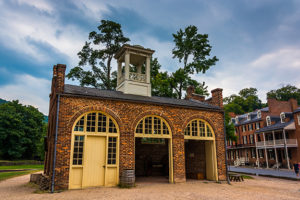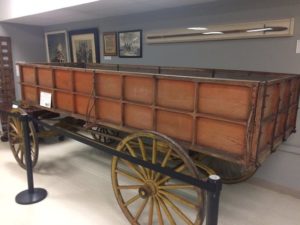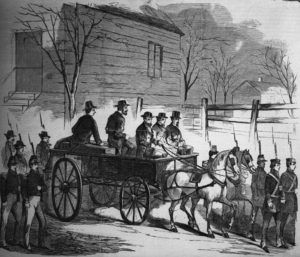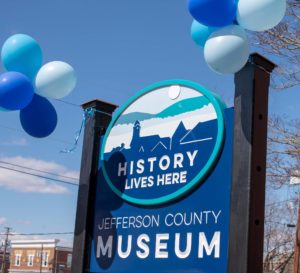
Technical Writer
Christine joined Synergy in 2019 as a tech writer for the cyber security team in Kearneysville, W.Va. Before that, she worked as a reporter and editor at The Plain Dealer in Cleveland and other newspapers. Her community involvement includes serving on the board of the Jefferson County (W.Va.) Historical Society.
When Synergy staffers arrive at the office in Kearneysville, W.Va., they’re focused on the tasks at hand, but workers interested in American history may want to stick around after hours and have a look around this part of the Mountain State.
Though the area is quiet and far from the national spotlight, this part of West Virginia is home to a plethora of history—including sites with ties to the famous slavery fighter John Brown, first president George Washington, the formation of the state of Ohio, and even presidential assassin John Wilkes Booth.
Here’s a look at 10 Jefferson County spots worth the trip:
About 7 miles from Kearneysville in Charles Town, the courtroom where a Virginia judge sentenced Brown to death in 1859 stands at the corner of Washington and Mildred streets. Largely rebuilt after sustaining damage during the Civil War, it’s still the working courthouse for Jefferson County.

Explore Harpers Ferry, where Brown staged his 1859 attack on the federal arsenal in hopes of beginning an uprising of the enslaved that would finally bring an end to slavery in America, and you can step inside “John Brown’s Fort,” the small engine house where federal troops arrested Brown early on Day 3 of his raid. Over the years, the structure was relocated four times—including as far away as Chicago—but it’s now back close to its original spot in Harpers Ferry’s “Lower Town.” Within sight of John Brown’s Fort, you’ll see where the Shenandoah and Potomac rivers come together. It’s all part of the Harpers Ferry National Historical Park, just 14 miles from Kearneysville.


Images from Christine Snyder
Go to the Jefferson County Museum to see thousands of relics, including the wooden wagon that took Brown to the gallows. The wagon, used by the Sadler family for decades after Brown’s death to deliver furniture, is on display along with thousands of other relics at the Jefferson County Museum at 200 E. Washington St.
Please note: Because of the COVID-19 pandemic, visitors are allowed at the Charles Town museum only on Thursdays and Fridays and must make an appointment at least 24 hours in advance by calling 304-725-8628.
Visit 515 S. Samuel St. in Charles Town, the site where Brown was executed on Dec. 2, 1859. At the time that Brown was put to death, the land was an open field just outside of downtown proper. 30 years later, John Gibson, who’d fought for the Confederacy, had a magnificent brick home built on the site—and not as any kind of tribute to Brown. On the street outside the five-bedroom, 7,000-square-foot home, there’s a historic marker. The turreted Queen Anne Victorian that’s listed on the National Register of Historic Places remains a private residence (and is said to be haunted).
Paddy’s Irish Pub in downtown Charles Town is in the historic Tiffin House, which takes its name from its first owner, English-born physician Edward Tiffin. He built the home at 210 W. Liberty St. and practiced medicine there starting in 1787 and then headed west in 1798 with a letter of recommendation from George Washington to help found the state of Ohio, becoming its first governor in 1803.
Stroll along Washington Street in Charles Town and you’ll be walking in the footsteps of Martin Delany, who was born in 1812 to a mother who was a free African American and an enslaved father in what was then the slave state of Virginia. During Delany’s childhood, it was illegal for anyone but white citizens to learn to read and write. When he was 10 years old, Delany’s family fled 57 miles away to Chambersburg in the free state of Pennsylvania. Delany would go on to win admission to Harvard Medical School in 1850 (although school officials gave him the boot a month in after white students reacted badly to his presence) and eventually went onto success as a scientist, inventor, newspaper publisher and Army major during the Civil War.
Happy Retreat at 600 Mordington Ave. in Charles Town was built starting in 1780 for George Washington’s younger brother, Charles Washington. He also founded the city of Charles Town and gave it his name. Streets in town including Charles, George, Mildred, and Lawrence are named for Washington family members. Long a private home, Happy Retreat today is owned by a nonprofit and is open to the public for classical music concerts and other special events. One of the most popular is the Happy Retreat Craft Beer and Music Festival every September.

Image from Christine Snyder
The Jefferson County Museum’s collection also includes a poignant letter handwritten by a grieving George Washington less than three months before his own death. Writing to his former aide-de-camp Col. Burgess Ball, Washington is grappling with the news of his brother Charles’s death.
“I was the first, and am now the last, of my father’s children by the second marriage who remain,” he says in the Sept. 22, 1799, note. “When I shall be called upon to follow them is known only to the giver of life.”
Frederick Douglass, who escaped enslavement in Maryland and became a noted social reformer and orator, spoke in Jefferson County on May 30, 1881, as part of the 14th anniversary of the founding of Storer College in Harpers Ferry. His address focused on Brown and concluded with these words:
“If John Brown did not end the war that ended slavery, he did at least begin the war that ended slavery. If we look over the dates, places, and men for which this honor is claimed, we shall find that not Carolina, but Virginia, not Fort Sumter, but Harpers Ferry, and the arsenal, not Col. Anderson, but John Brown, began the war that ended American slavery and made this a free Republic.”
Storer College would shut its doors in 1955 after the state of West Virginia cut off funding. Their rationale: With the U.S. Supreme Court’s Brown decision, African Americans didn’t need the historically black school and could attend the public college in Shepherdstown instead.
A modest stone building at the corner of North Lawrence and Liberty streets in downtown Charles Town (now a private home) has a tie to John Wilkes Booth. This Maryland-born actor-turned-assassin altered the course of American history when he slipped into the presidential box at Ford’s Theatre on the night of April 14, 1865.
In the fall of 1859, Booth was rehearsing a play in Richmond, Va., when he happened to see the Richmond Grays, a state militia headed by train to Charles Town for Brown’s trial. Booth, who’d attended military school as a teenager, hastily assembled a uniform and joined up. Once in Charles Town, he spent his evenings entertaining trial-goers with Shakespearean readings at what was then the Episcopal Reading Room.
Booth, in uniform, was among the 2,000 people to witness Brown’s trip to the gallows (and future Confederate leaders Robert E. Lee and Stonewall Jackson saw it too). An ardent supporter of slavery, Booth nonetheless found something to admire that day, later telling his sister that Brown was a “brave old man.” Some historians say that seeing Brown bravely go to his death might have inspired Booth to aim for martyrdom with his takedown of the president less than a week after the Civil War’s end.